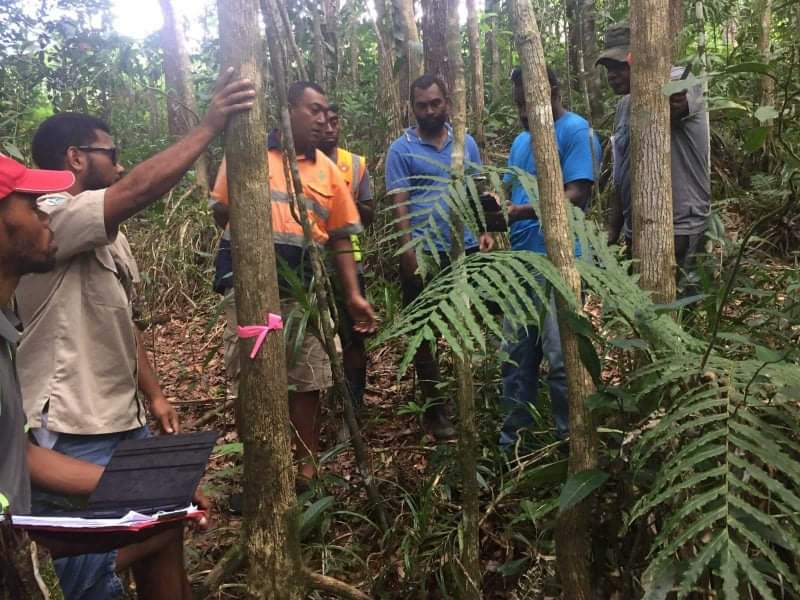
Inventory to provide valuable insight into Fiji’s Forests
The
Ministry of Forestry will this year conduct a National Forestry Inventory (NFI)
to capture accurate information about the size, distribution, composition and
condition of Fiji’s forests and trees.
A
National Forestry Inventory (NFI) is an assessment regularly conducted to take
stock of the existing forests, both natural and planted, and is done through
the systematic collection data collection of forest information.
Essentially,
the NFI involves the measurement of tree heights and diameters to calculate the
different elevations and locations, assess the health of the forests, count the
trees and structure of the forest and the important parameters measured
including the species, diameter at breast height, tree height, site quality,
age and defects.
The
data analysis calculates the number of trees in a given area (acres, hectares),
the volume in a given area and the basal area.
It
is a common procedure to establish Permanent Sample Plots - of a standard size
- in randomly selected locations, which are revisited each year for the
collection of tree measurement data for calculating annual tree growth rates.
In
order for a National Forest Inventory to be carried out, it is important that a
methodology and guideline is developed. To this effect, the Ministry of
Forestry through the REDD+ Unit sought assistance from the German consultancy
firm – Unique Forestry who together with local forestry technical experts helped
to create a methodology and guideline for the 2021 NFI.
The
projected NFI methodology and guideline came about following an assessment of
raw processed data and procedures from Fiji’s 2005 NFI and the last
measurements of the PSPs that were conducted in 2016.
Permanent
Secretary for Forestry Pene Baleinabuli said the last NFI was conducted in 2005
and with the onset of changes to land use through various forms including but
not limited to agriculture, infrastructure development and natural disasters,
it is important for Fiji to carry out another inventory of its forests.
“A
NFI is essential for the collection of comprehensive information and for developing
and monitoring policies and guidance that support the sustainable management of
Fiji’s forests,” he said.
Mr.
Baleinabuli said that Fiji has conducted 3 inventories of the country’s forests
– in 1969, 1991 and 2005. The findings of these inventories are documented in
official reports.
“All
three previous NFIs were focused on the availability of commercial timber in
Fiji’s natural forests so the current data has limited use in a broader context
which could include having information on non-timber forest products and even
on the value of carbon.”
He
said that for this year’s NFI, field data collection will also include forest
carbon measurements and biodiversity.
The
NFI, he said will also define policy and trade decisions, national and
international reporting and the direct and indirect contribution of forests to
reducing the effects of climate change and alleviating poverty.
The
collation of information of our forests is also critical in a COVID-19 era with
the general expectation that resource-based sectors like forestry could help
re-ignite economic growth.
“The
NFI will also look at other related forestry sectors such as the Greenhouse Gas
(GHG) inventory as part of the Intergovernmental Panel on Climate Change (IPCC)
requirement of completeness and will look at the integration of agriculture,
land use, land-use change and forestry (LULUCF) sectors from previous
guidelines (2003 GPG-LULUCF) into one sector called the agriculture, forestry
and other land use (AFOLU),” PS Baleinabuli said.
The
AFOLU involves six land use categories which covers emissions and removals from
the terrestrial biosphere and provides carbon and GHG estimation methodologies
for carbon pools in land-use categories. The six land use classifications
include Forest land, Cropland, Grassland, Wetland, Settlement and Other land.
For
REDD+ (Reducing Emissions from Deforestation and Forest Degradation, Forest
Conservation, Sustainable Forest Management and Carbon Stock Enhancement) work,
an NFI is essentially to estimate carbon stock change that meets the United
Nations Framework Convention on Climate Change (UNFCCC) requirements and to
capture biodiversity.
Conducting
an NFI is also one of the key sources of relevant data for national Green House
Gas (GHG) reporting, Forest Reference Emissions Level and Forest Reference
Level (FREL/FRL) construction and reporting at international level.
NFIs
are a key information source for modern approaches to forest management and
associated planning processes.
This
NFI 2021 will provide necessary information and insight into the condition of
Fiji’s forests because keeping the forests healthy is important for sustainable
forestry management.
Mr.
Baleinabuli said the NFI will be conducted over the next six months and it is
likely that the updated information on Fiji’s forests will be publicly available
by December
2021.
He acknowledged the assistance of the World Bank through the Forests Carbon Partnership Facility which has supported Fiji’s REDD+ programme since 2013, and the German Technical Cooperation which helped establish Fiji’s REDD+ programme in 2009.